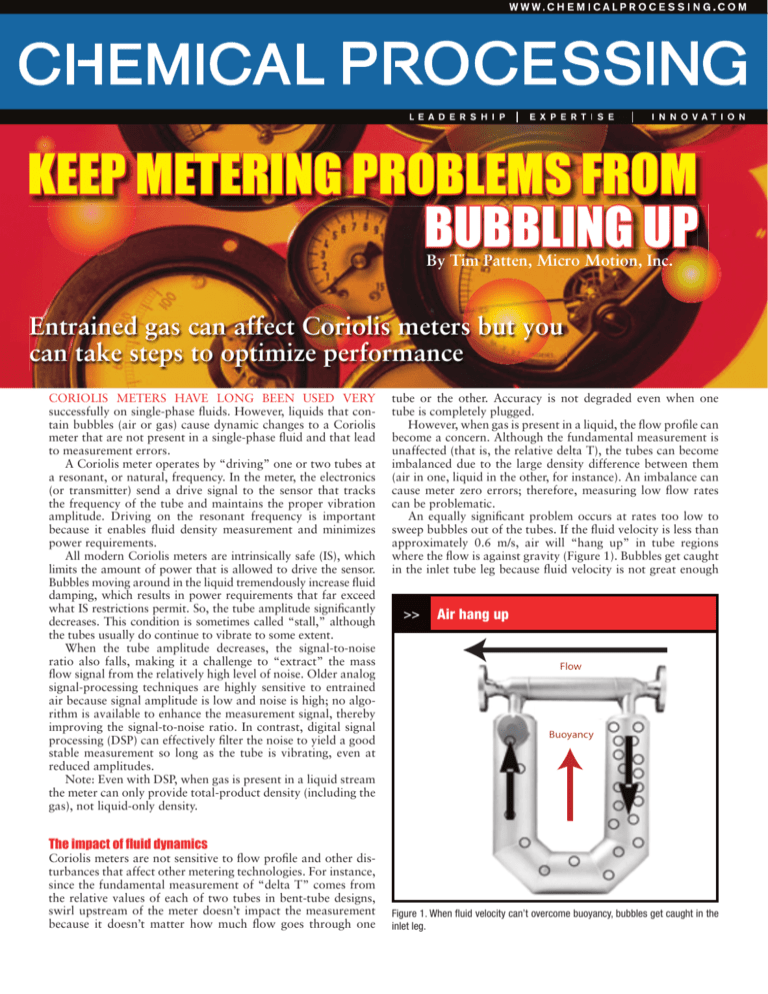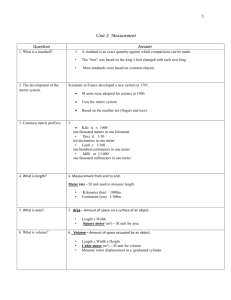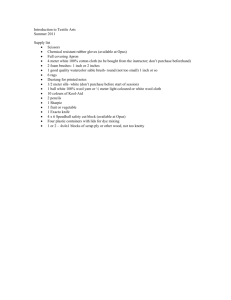
KEEP METERING PROBLEMS FROM
BUBBLING UP
By Tim Patten, Micro Motion, Inc.
Entrained gas can affect Coriolis meters but you
can take steps to optimize performance
CORIOLIS METERS HAVE LONG BEEN USED VERY
successfully on single-phase fluids. However, liquids that contain bubbles (air or gas) cause dynamic changes to a Coriolis
meter that are not present in a single-phase fluid and that lead
to measurement errors.
A Coriolis meter operates by “driving” one or two tubes at
a resonant, or natural, frequency. In the meter, the electronics
(or transmitter) send a drive signal to the sensor that tracks
the frequency of the tube and maintains the proper vibration
amplitude. Driving on the resonant frequency is important
because it enables fluid density measurement and minimizes
power requirements.
All modern Coriolis meters are intrinsically safe (IS), which
limits the amount of power that is allowed to drive the sensor.
Bubbles moving around in the liquid tremendously increase fluid
damping, which results in power requirements that far exceed
what IS restrictions permit. So, the tube amplitude significantly
decreases. This condition is sometimes called “stall,” although
the tubes usually do continue to vibrate to some extent.
When the tube amplitude decreases, the signal-to-noise
ratio also falls, making it a challenge to “extract” the mass
flow signal from the relatively high level of noise. Older analog
signal-processing techniques are highly sensitive to entrained
air because signal amplitude is low and noise is high; no algorithm is available to enhance the measurement signal, thereby
improving the signal-to-noise ratio. In contrast, digital signal
processing (DSP) can effectively filter the noise to yield a good
stable measurement so long as the tube is vibrating, even at
reduced amplitudes.
Note: Even with DSP, when gas is present in a liquid stream
the meter can only provide total-product density (including the
gas), not liquid-only density.
tube or the other. Accuracy is not degraded even when one
tube is completely plugged.
However, when gas is present in a liquid, the flow profile can
become a concern. Although the fundamental measurement is
unaffected (that is, the relative delta T), the tubes can become
imbalanced due to the large density difference between them
(air in one, liquid in the other, for instance). An imbalance can
cause meter zero errors; therefore, measuring low flow rates
can be problematic.
An equally significant problem occurs at rates too low to
sweep bubbles out of the tubes. If the fluid velocity is less than
approximately 0.6 m/s, air will “hang up” in tube regions
where the flow is against gravity (Figure 1). Bubbles get caught
in the inlet tube leg because fluid velocity is not great enough
>>
Air hang up
Flow
Buoyancy
The impact of fluid dynamics
Coriolis meters are not sensitive to flow profile and other disturbances that affect other metering technologies. For instance,
since the fundamental measurement of “delta T” comes from
the relative values of each of two tubes in bent-tube designs,
swirl upstream of the meter doesn’t impact the measurement
because it doesn’t matter how much flow goes through one
Figure 1. When fluid velocity can’t overcome buoyancy, bubbles get caught in the
inlet leg.
>>
Empty-full-empty batching can pose a related measurement issue. Such batching
is most common to avoid cross-contamination of products when filling large tanks
such as rail cars or trucks. Therefore, the loading line is purged with air or other
inert gas between loads, leaving the meter empty before and after the batch.
Generally, this application is not too difficult because the batches tend to
be long (greater than one minute). Any transient meter behavior at the beginning and end of the batch is small compared to the whole batch, so errors are
“washed out.”
However, when batches are short (less than one minute), the transient errors
can account for a significant fraction of the total error. Air may be entrained for a
brief period, but the main issue is the time it takes to fill the meter with fluid. For
instance, an application running at 3 m/s will take about 0.1 s to fill if the tube
length is 0.3 m; an application at 0.3 m/s will take a full second simply to fill the
meter. Experience has shown that if the meter fill-time is less than 0.1 sec., good
batching performance can be achieved, regardless of the meter’s tube geometry.
Performance with water
0.8
0.6
0.4
Mass flow error, %
A special case
0.2
0.0
-0.2
-0.4
-0.6
-0.8
-1.0
0
0.5
1
1.5
3
2
2.5
Average void fraction, %
3.5
4
4.5
Figure 3. Meter provides accurate results for water containing up to 4% void fraction
because flow rate is high, 38,000 kg/h.
to push the bubbles down and out against gravity forcing the
bubbles up. This issue is present in any bent-tube meter design
because at some location in the tube the fluid velocity is fighting
gravity.
The solution is to keep flow rate high enough such that fluid velocity can purge the sensor of air. A rate of 20% of meter nominal
flow (1 m/s in the flow tube) or higher is adequate to completely
purge the meter of bubbles and give good performance. In a Ushaped meter, mounting the sensor in a vertical pipe run with flow
going up helps to keep the bubbles moving through the meter.
The role of fluid properties
Pressure, fluid temperature and viscosity all impact how a Coriolis meter deals with varying levels of entrained air.
As pressure increases or decreases, the apparent void fraction changes, of course. This means, for instance, if two meters
>>
Performance with high-viscosity fluid
2“ Meter on toothpaste
Viscosity = 10,000 cp
0.8
0.6
Future improvements
0.4
Mass flow error, %
are piped in series, the downstream meter is at a distinct disadvantage because the pressure is lower and therefore the void
fraction is higher.
Temperature plays a minor role, in that it affects viscosity and
surface tension. It also impacts void fraction to a small degree (higher temperature results in higher void fraction).
Viscosity is a very important fluid parameter because it directly influences the propensity of the fluid to hold up air (or gas).
In a low-viscosity liquid such as water, air bubbles coalesce from finely
distributed small bubbles into large ones that collect at high points in
the line. In contrast, if the bubbles stay finely distributed, as happens
in high-viscosity liquids, they will be purged from the meter easily and
not collect — and metering will be accurate. Figure 2 shows results
for toothpaste with a viscosity of 10,000 cP and entrained air level
between 2 and 5%. Rates are quite low for a 2-in. meter (<0.6 m/s)
yet performance is well within specification.
The opposite viscosity extreme is water where air will always
tend to separate. If velocity is high, bubbles tend to stay finely
divided, which helps to keep the air well mixed. Figure 3 shows
very good performance because mixing is good due to the high
flow rate (38,000 kg/h). If the velocity is low, bubbles collect at
locations in the meter flow tubes or piping where the flow direction is against gravity. Errors can easily exceed 5% if the velocity
is less than 0.6 m/s — and therefore mixing is poor.
0.2
0
-0.2
-0.4
-0.6
-0.8
-1
0
50
100
150
200
250
300
350
400
450
Flow rate, lb/min
Figure 2. Even at low flow rate, measurements for 10,000-cP toothpaste with 2-5%
void fraction are within specification.
Transmitters in development will enable accurate measurement of
lower rates. There will always be a physical limit to the minimum
rate that can be measured because of the previously described separation issues. However, noise rejection improvement with new DSP
techniques will allow the minimum rate to be pushed lower.
A significant problem with any two-phase flow (water/air, dog
food with solids suspended in water, oil/gas, etc.) is at zero flow.
When the flow is stopped, the multiple phases separate by gravity, prompting an imbalance in the tube. This imbalance causes
an apparent meter zero change. Work on signal processing improvements to address this problem is currently a significant area
of research. CP
Tim Patten is director of measurement technology for Micro Motion, Inc., Boulder, Colo. E-mail him at Tim.Patten@EmersonProcess.com.
Reprinted with permission from Chemical Processing, November 2005.
© PUTMAN. All Rights Reserved. On the Web at www.chemicalprocessing.com.
AR-00861








